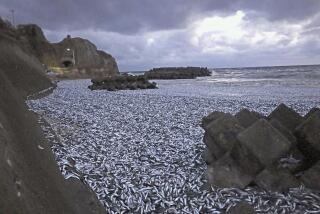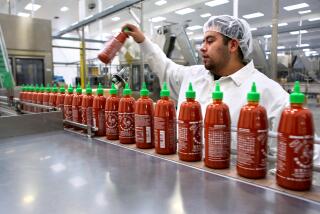Hoarding Results in Japan Rice Shortage
- Share via
TOKYO — As Japan opened its long-protected rice market Tuesday to full-scale sales of foreign-domestic blends, consumers responded by sweeping shelves bare of domestic varieties.
When trial sales of imported rice began last month, curious consumers and bargain hunters bought out supplies at some stores within hours, raising the hopes of those who want to see a smooth penetration of Japan’s market by foreign varieties.
In recent weeks, however, the discovery of mold or discoloration in some import shipments and concerns about taste has led to panic buying of domestic varieties. And some rice merchants are hoarding scarce domestic supplies for favored customers who don’t want to have to buy the mixed blends.
Thus, even as imports are introduced to make up for a poor domestic harvest, Japan faces an artificially created rice shortage.
By Tuesday, matters had become so severe that at some stores, not only did domestically grown varieties disappear, but the new blends of 30% domestic and 70% foreign rice sold out as well.
A newscaster on Fuji Television compared the buying frenzy to an irrational run on toilet paper in the fall of 1973, when consumers became frightened that the shock of rapidly rising oil prices would somehow lead to a shortage of that commodity.
“This is the first time since right after World War II that we’ve experienced a rice shortage,” said an elderly man at a supermarket that had run out of all varieties of rice.
However, officials stressed that with the availability of imports, there is no actual shortage.
“I was anticipating this sort of phenomenon,” Agriculture Minister Eijiro Hata told reporters at a news conference in which he urged the media not to worsen the panic buying. “Please cooperate, and understand that the absolute quantity of rice is sufficient.”
Current sales are of “emergency” imports to make up for last year’s crop losses due to bad weather in Japan. But because Japan agreed during multilateral trade talks in December to a permanent, partial opening of its rice market, starting in 1995, these imports are seen here and abroad as the opening shot in a foreign assault on the market.
The government, which controls most rice distribution, had earlier announced that it planned to mix domestic and foreign varieties. But many consumers had not realized until very recently that standard government rice--the kind most widely available--would contain 70% imported varieties for the next eight months. Imports are from California, China and Thailand. Tuesday was the first day for the rice to be widely offered in stores across Japan.
Consumer concerns over the quality of imports were heightened Monday evening when Yuko Takasaki, a member of Parliament’s upper house, received nationwide television news coverage for a dramatic attack on the quality of imported Thai rice. Speaking before a budgetary committee, she charged that dead mice, dead cockroaches, cigarette butts, metal bars, pebbles and rubber bands had been found in the rice. A photograph of a dead mouse that she used to illustrate her charges was also broadcast.
The government’s Food Agency, responsible for rice supplies, has announced that out of 50,000 tons of imported rice it handled during February, mold or discoloration was found in 141 tons. The discovery of such problems has received considerable media coverage.
Partly as a result, the price of popular domestic brands has soared. One supermarket that opened Tuesday morning with high-quality koshihikari rice offered at $62 for a 22-pound bag--well above its usual price--had sold out a 100-bag supply within 45 minutes.
A rice shop owner interviewed by Fuji Television admitted that he was offering Japanese rice only to steady customers.
More to Read
Inside the business of entertainment
The Wide Shot brings you news, analysis and insights on everything from streaming wars to production — and what it all means for the future.
You may occasionally receive promotional content from the Los Angeles Times.










